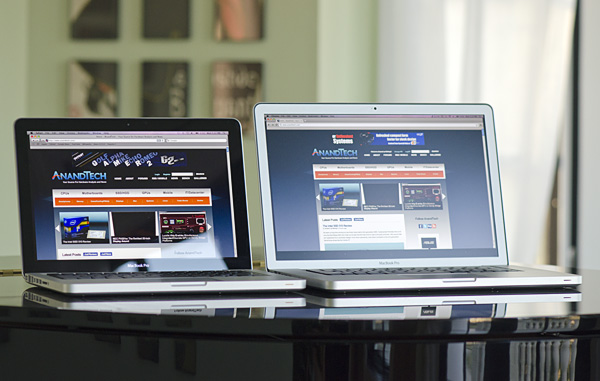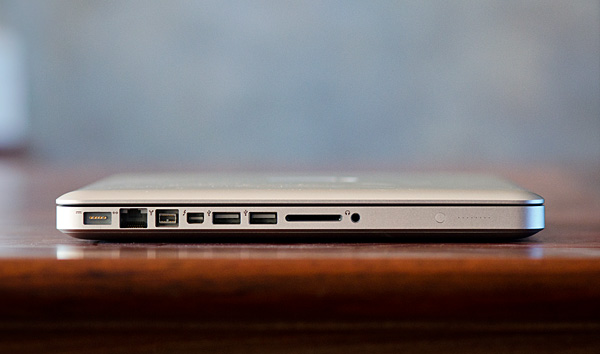The MacBook Pro Review (13 & 15-inch): 2011 Brings Sandy Bridge
by Anand Lal Shimpi, Brian Klug & Vivek Gowri on March 10, 2011 4:17 PM EST- Posted in
- Laptops
- Mac
- Apple
- Intel
- MacBook Pro
- Sandy Bridge
Final Words
For as little attention as the 2011 MacBook Pro launch was given by Apple, there sure is a lot to talk about.
The advantages are numerous. With the 13-inch MacBook Pro, under OS X at least, there simply aren't any downsides. You get much better CPU performance over the previous generation. In fact, the new 13 can outperform last year's 15 thanks to Sandy Bridge. The new 13 is quite possibly the best balance of portability and performance. It's the single largest upgrade you'll find in the lineup. If you own a previous generation 13-inch MBP, the upgrade is 100% worth it. Graphics performance is solid under OS X however questionable under Windows. For some reason we actually saw a step back in GPU performance vs. last year's 13-inch MBP when running games in Windows 7.
The 15-inch MacBook Pro is a beast. Although it comes in the same chassis as last year's model, it delivers much more performance. The move to quad-core Sandy Bridge makes the 15-inch MacBook Pro's performance formidable. Whereas I couldn't use the 2010 15 as my primary work machine, with an SSD the 2011 15-inch MBP does just fine.
Displays haven't really changed, which is both good and bad. On the one hand, Apple's MacBook Pros have always used good quality panels. On the other hand I'd like to see a higher res option for the 13-inch display—1280 x 800 is a big turnoff for me with the 13-inch model.
Thunderbolt is a nice addition however I expect that it'll be grossly underused for a while. We'll see some nice Thunderbolt enabled external storage solutions this Spring (helping perpetuate the mobile desktop usage model), but it'll be a while before we get the single-cable carrying USB, Ethernet, FireWire and DisplayPort to a display.
The WiFi improvements are welcome, although surprisingly absent from Apple's marketing collateral. The front facing 720p camera is also a nice touch.
It's not all rosy however. Apple fails to really take advantage of one of Sandy Bridge's biggest features: Quick Sync. The hardware encoder is used in FaceTime HD but you still get some very high CPU usage (at least of a single core). There's no support in QuickTime or iMovie 2011 for Quick Sync as of now, which is a major disappointment.
I mentioned that the 15-inch MacBook Pro is easily a desktop replacement, however you do have to deal with a loud fan under heavier CPU loads. Something a well designed desktop won't bother you with.
SSD support is still problematic. There are far too many reports of drives that don't work properly in the 2011 MacBook Pro, and Apple refuses to validate/ship anything but fairly mainstream SSD solutions. To make matters worse, although TRIM is finally enabled under OS X—it only works on Apple branded SSDs. I can understand Apple's desire to want to avoid dealing with the pitfalls of early SSDs with questionable firmware maturity, but I also believe it's Apple's duty to support as much hardware that's out there in the market today. If Apple offered something with SandForce SF-2200 class performance I'd have less of a bone to pick, but presently it doesn't.
Then there are the concerns about battery life. Under light usage there's a clear improvement over last year's models. The new 15-inch MacBook Pro is good for anywhere between 7—9 hours of light usage. That is assuming you don't have the dGPU running of course, at which point you should start talking about numbers below 5 hours. Even without the discrete GPU enabled, in the hands of a multitasker the new 15-inch MacBook Pro can easily burn through its 77Whr battery quicker than last year's model. While our worst case numbers don't look much lower than the 2010 model, the chances of you getting less than 2.5 hours out of the new 15 are much higher than they were last year.
The new 13-inch model is less of a concern when it comes to battery life. It's still got a 35W TDP dual-core CPU and no discrete GPU to sap power. It's the move to four cores and the additional GPU that really hurt the 15-inch MacBook Pro under heavy usage.
Overall the new lineup is a significant step forward. As I mentioned earlier, if you're in the market for a 13-inch system the 2011 Sandy Bridge MacBook Pro is likely the one to get. The 15 is just as easy to recommend, provided you're ok with the downsides (higher temperatures, louder fans, shorter battery life under load). If you aren't ok with the downsides, just wait another year and get the Ivy Bridge based successor.












198 Comments
View All Comments
brettski - Thursday, November 10, 2011 - link
Total NYC sales tax is 8.875%.NY state tax is only 4.5%
brettski - Thursday, November 10, 2011 - link
i'm sorry... state is 4%, city is 4.5%, plus Metropolitan Commuter Transportation District surcharge of 0.375%= 8.875% sorry... mixed up the city and state rates.gstrickler - Thursday, March 10, 2011 - link
What are you talking about? Most of us non-gamers don't even need a dedicated GPU, much less 256MB of graphics memory. I'm currently running on a late 2007, 15" MBP which has an 8600M GPU with 128MB of graphics RAM, and I only use it because there is no IGP on this machine. Once you get to the level of the Nvidia 9400M, IGP is plenty for a non-gamer, and even 32MB allocated to graphics RAM is more than adequate. The exception is if you need OpenCL support, since Intel's IGPs don't support OpenCL.I wish Apple offered a 13" MPB with a higher resolution (1440x900) matte display or a 15" with AES-NI and without a dGPU. I could use the faster CPU and HT, but I don't really need quad-core (but it's nice to have it available when on AC power), and battery life is far more important to me than a GPU or maximum CPU speed.
In fact, what I would really like is a 15" with matte display, no dGPU, Core i7-2720QM (for AES-NI support) with the ability to disable 2 cores/4 threads when on battery power. The 2011 15" lets me get close, if I use gfxcardstatus to disable the dGPU. If I can get software to disable 2 cores when on battery, it'll give me everything I'm asking for, but at a fairly hefty premium ($+150 for the matte display, $+400 for the Core i7-2720QM and Radeon 6750M + 1GB that I'll never use). Of course, what that means is that I'll either get the entry level 15" without AES-NI support and use gfcardstatus to disable the dGPU, or I'll wait for the next update and see if the options are any better.
Notes to Apple:
1. Make a matte screen an option on all machines, for no more than a $50 premium (no forced upgrade to a higher resolution)
2. Offer a 15" without a dGPU (e.g. make the dGPU a separate plug-in module)
3. Offer a 1440x900 screen for the 13" MPB.
I doubt I'll see any of those, but it doesn't hurt to ask.
tipoo - Thursday, March 10, 2011 - link
"Most of us non-gamers don't even need a dedicated GPU"Most people don't need a truck, that doesn't mean no one does. This is branded as a pro machine, and at nearly 2 grand the GPU doesn't fit the bill.
alent1234 - Friday, March 11, 2011 - link
MAcbooks are thin, long battery life, nice screen and good build quality first. specs second. until sandy bridge came out laptops with long battery life cost just as much as a macbook or more.a lot of the people that buy these are mobile pro's who need to use a laptop for hours while away from a power source
sync216 - Thursday, March 10, 2011 - link
256MB is fine for the 64xxM series GPUs. The performance improvement going to GDDR5 and a faster GPU is much higher than the improvement from 256 to 512 would have given. For customers who really need the additional graphics performance (and corresponding graphics memory) apple is offering the very fast 6750M with 1GB.Demon-Xanth - Thursday, March 10, 2011 - link
...Apple is more like Sony than Acer? Their core buisness is no longer computers, but gadgets.michael2k - Friday, March 11, 2011 - link
Um, this was evident in 2001 when the Titanium PowerBook was first unveiled, then the iPod later that year, then the music store in 2004, etc.Also, you have it backwards, their core business is computers, they just happen to know how to turn computers into gadgets. They treat the iPod like a computer (firmware updates on a regular basis), which means they aren't disposable. Contrast that to the average phone OEM with Android who won't see updates for longer than 6 months, where Apple pushes updates to their iPhone for over 29 months.
jameskatt - Friday, May 6, 2011 - link
Nearly all of Apple's products are computers:Mac Pro = desktop expandable computer running OS X
iMac = all-in-one desktop computer running OS X
Mac Mini = non-expandable desktop computer running OS X
MacBook Pro = high end laptop computer running OS X
MacBook Air = high end netbook computer running OS X
MacBook = basic laptop computer running OS X
iPad = tablet computer running OS X
iPhone = handheld tablet computer with phone running OS X
iPod Touch = handheld tablet computer running OS X
AppleTV = multimedia appliance computer running OS X
OS X has two variations - Mac OS X and iOS. The core operating system is the same for both.
Apps for both are written using Apple's XCode Development System.
quiksilvr - Thursday, March 10, 2011 - link
I'm surprised SSD isn't standard to begin with. $1199 for a 13" laptop and you don't even get dedicated graphics? Seriously? The HDDs aren't even 7200rpm. This is insulting to the nth degree.If you want a solidly built, well-spec'd, thin and fairly priced system, get the Envy 14. You get 7200rpm HDD, dedicated graphics, an HD webcam with TWO microphones (necessary for sound cancelling), a backlit keyboard and even Photoshop and Premiere.
Until Apple drops their prices to a realistic and reasonable level, avoid it completely.